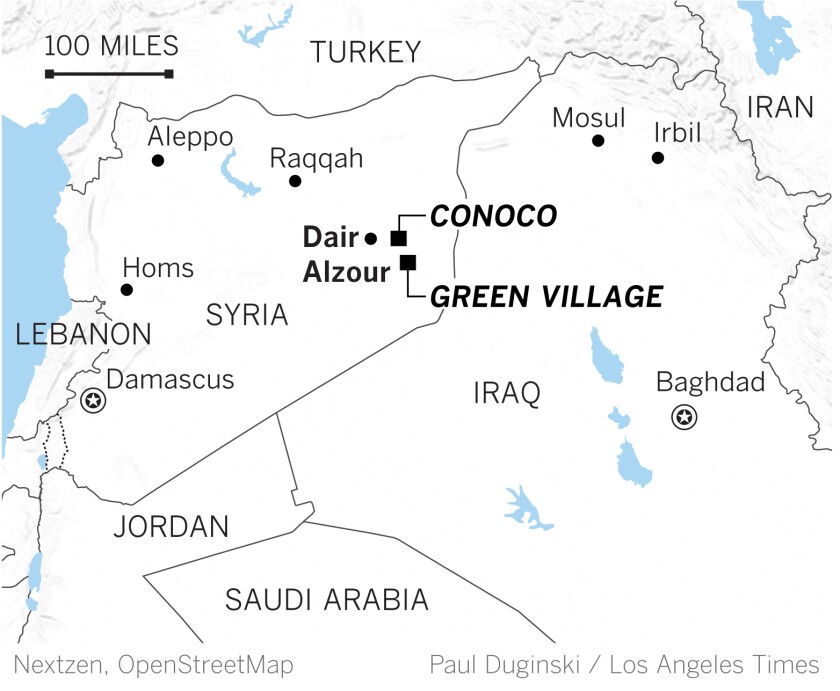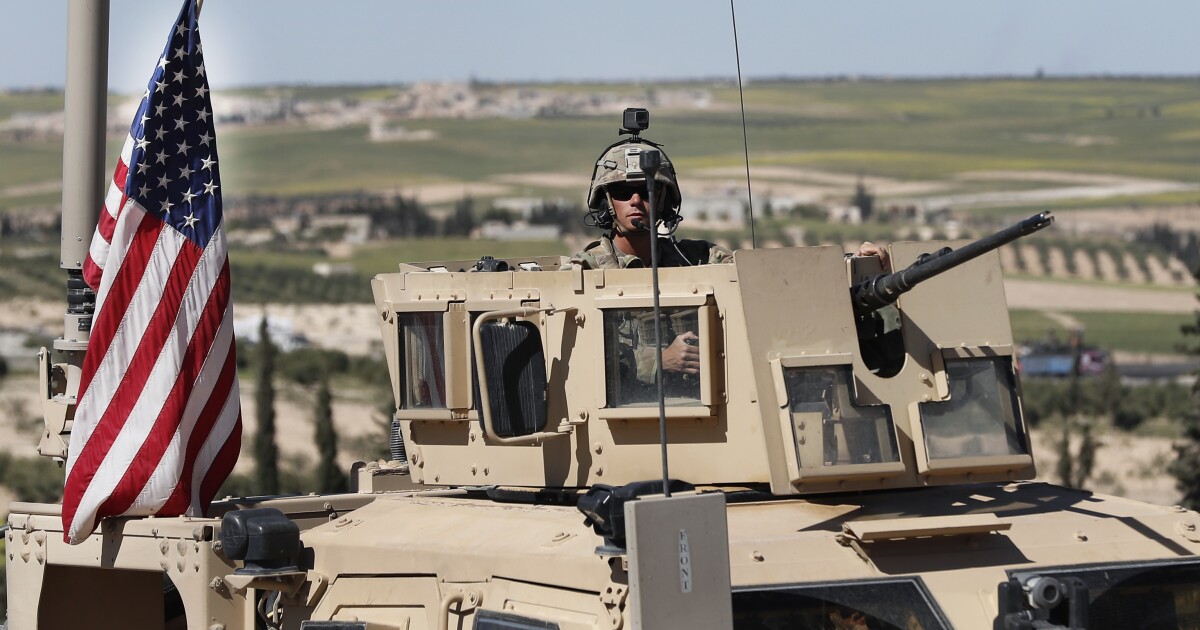At a makeshift military post near a natural gas field in eastern Syria, signs of the country’s violent uprising are everywhere. Bombed concrete buildings are in ruins. The pipes that previously carried liquefied natural gas are crushed and twisted.
A tattered US flag hanging between 12-meter-high gas processing towers flies high over the base, a visible symbol that American troops are here – and they are not planning to leave any time soon.
“We have the mast planted,” said Army Lieutenant Alan Favalora, a Louisiana National Guard soldier in Conoco, a name the base acquired from the former United States oil and gas company that operated the wells. “We want them to know that we are committed to this region.”
How committed President Biden will be to maintaining troops in Syria is uncertain, however.
The Biden government does not appear to be in a hurry to withdraw the 900 American soldiers remaining in the country, a relatively small force that some White House officials see as the key to preventing the resurgence of the Islamic State and the race to recover the area. oil fields by Syrian President Bashar Assad and his Russian and Iranian allies.
But White House officials said they are reviewing the presence of troops in Syria – an announcement that raised concerns that Biden might reconsider the deployment as part of a further reduction of US troops in the Middle East and a planned shift from the Pentagon’s focus to Asia.
What Biden is going to do “is the only question I get from everyone,” said General Kenneth “Frank” McKenzie Jr., the top US commander in the Middle East, in an interview after visiting eastern Syria on Friday. “I think the new government is going to look at this and then get guidance.”
Robert Ford, who was ambassador to Syria during the Obama administration, called the US strategy “deeply flawed” and said Biden should withdraw the remaining troops that helped the Syrian Democratic Forces – a Kurdish-led militia – to create a semi-autonomous enclave in the northeast of the country.
“I don’t think it’s worth it,” said Ford of the American deployment in an interview. The Islamic State “is largely contained and is not in a position to threaten the homeland of the United States or even to send fighters to Europe”.
The Arab population in northeastern Syria initially supported the efforts of Kurdish militias to overthrow the Islamic State. But many Arabs now resent being under the Kurdish government, creating a new source of recruits while Islamic State tries to recover, Ford added.

Conoco is one of several small outposts used by US troops and the Syrian Democratic Forces, or SDF, to form an enclave outside Assad’s control. This brought relative stability to a part of a country that is fighting a decade-long civil war that has taken a terrible human toll.
Hundreds of thousands of people have been killed since the civil war broke out in 2011; in 2016, the United Nations estimated the number at 400,000. And millions more – half the population – have been displaced or have fled the country, according to the United Nations.
The Syrian army is conducting its own struggle against the Islamic State, supported by Russian mercenaries, advisers to the Iranian Revolutionary Guard and irregulars supported by Iran from Lebanon, Iraq and Afghanistan. Syrian forces are supported by Russian warplanes and Iranian drones.
Russian and Syrian troops are on the other side of the Euphrates River from Conoco, but both sides avoid entering the territory of the other.
“There is a very hard line,” said Favalora. “They can’t come here and we can’t go there.”
In 2018, hundreds of Russian mercenaries and members of the pro-government militia were killed by U.S. air strikes and artillery when they crossed the Euphrates just a few kilometers from Conoco.
The US partnership with the SDF helped to consolidate its control over eastern Syria, creating an alternative to the Assad government and perhaps a bargaining chip if efforts to reach a political settlement for the civil war advance.
But maintaining troops in eastern Syria also helps the Pentagon to control the Iraq-Syria border, containing Iran’s growing influence in the region.
There are few vestiges of Islamic State fighters who dominated a large area of eastern Syria and Iraq, including the wells, until they were expelled by Kurdish and Arab militias, aided by US air strikes and special forces troops. American officials say the group has less than 10,000 followers, many of them forced into remote areas of mountains or deserts, making it impossible to maintain large expanses of territory or mount mass attacks, especially in areas controlled by the SDF.
“We believe they still aspire to stand their ground” in Syria and Iraq, said McKenzie. “But it is difficult for them to get together, because when they do, we catch them.”
With the Biden government just beginning to consider options in Syria, US military commanders are careful not to rule out further withdrawals. But they warn that a withdrawal, along with cuts in air support, intelligence and other forms of assistance to the SDF, would create a security vacuum that Islamic State could exploit.
“What would happen if we withdraw is an issue that we need to look at,” said McKenzie. “Because we are there, there is an element of stability.”
American officials warn that the withdrawal of American troops would likely paralyze the SDF, forcing Kurdish fighters to retreat to an even smaller area in northeastern Syria and reach an agreement with Assad.
It can also lead to escapes from detention camps run by Kurds who keep thousands of ISIS fighters and the relatives of militants and supporters from crowded refugee camps. It is estimated that 70,000 people who have lived under the rule of Islamic State are in Al Hol, the main detention center run by Kurds, about 80 kilometers south of the border with Turkey.
Biden is already finding it difficult to disconnect militarily from the mix of militias, outside powers and regime forces operating in Syria. His first publicly known military action was to order an air strike in February against a camp in Syria, near the border with Iraq, in retaliation for the attack by an Iranian-supported militia against an American base in Iraq.
How to forge a response to the chaos in Syria has plagued American authorities since the start of the civil war.
In order to diminish the American military presence in the region, ex-President Obama focused on the provision of humanitarian aid and political negotiations for the removal of Assad. Obama approved secret military aid in the hope of creating a moderate Syrian rebel force as a counterattack to more militant fighters, a timid effort that has yielded scant results.
After Assad used sarin and other chemical agents against rebel-controlled areas in 2013 near Damascus, the capital, and in northern Aleppo province, Obama prepared military retaliation against the government, but canceled the attack shortly before the start.
When the Islamic State emerged in 2014, capturing a third of Syria and Iraq for its so-called caliphate, Obama sent troops back to Iraq and approved air strikes in Syria. In Kobani, a city in northern Syria near the border with Turkey, the American aerial bombardment helped Kurdish fighters to end a siege on the Islamic State.
Former President Trump has repeatedly promised to withdraw after the almost complete defeat of the Islamic State in early 2019. He announced a withdrawal in December, after a US attack killed Islamic State leader Abu Bakr Baghdadi. But the president backed down after Defense Secretary James N. Mattis resigned in protest and White House advisers warned that a very rapid withdrawal would allow the Islamic State to regroup.
Last year, Trump ordered the removal of American forces from the northern border near Turkey as part of a movement planned to withdraw all American troops from the country. But, under pressure from the Pentagon, he later agreed to keep US forces in the east to continue working with the SDF and help protect Islamic State’s oil fields.
Now, in Green Village, another base in Syria, east of the Euphrates River, American soldiers are housed in dilapidated apartments that were previously used by oil field workers. A huge M777 artillery cannon is almost idle, as there are not many Islamic State fighters to aim for, said Army Lieutenant Melissa Cardona.
Every two weeks, however, Cardona said, soldiers fire a long-range salvo in remote areas where the group’s fighters are believed to be hiding – just to remind them “that we are still here.”
